'Last Chance U' Was Never Supposed to Be This Big
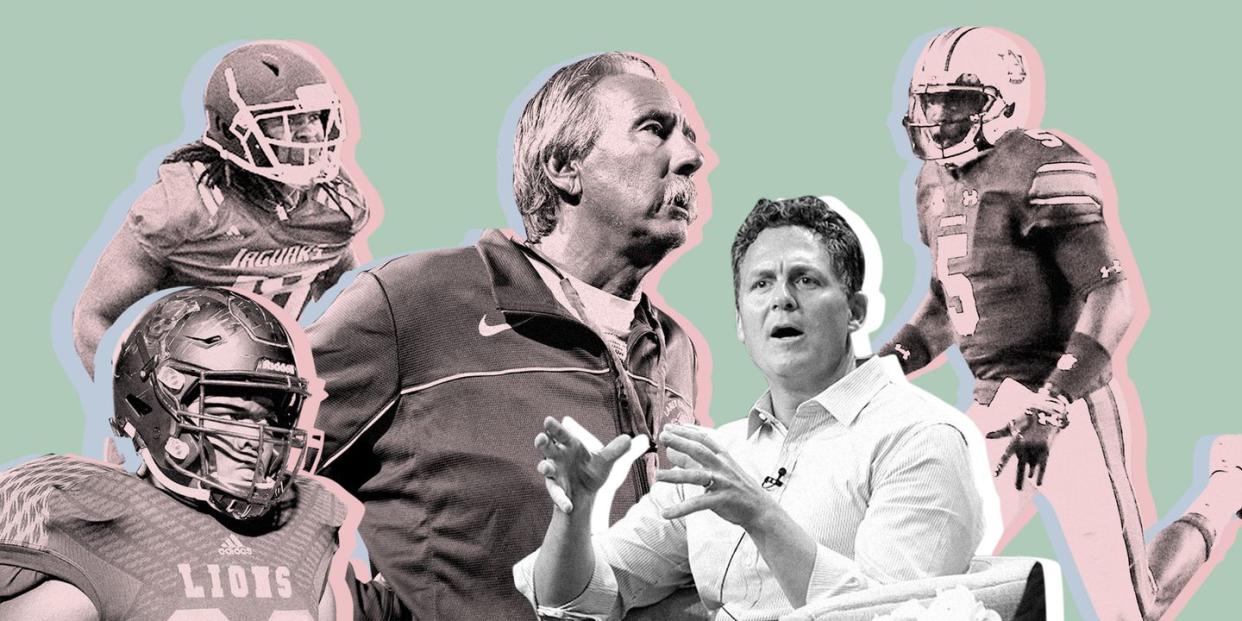
The email was definitely a prank. But who in their right mind would prank a football coach, who was probably last seen making some lineman bear crawl 80 yards down the field, screaming at him the whole way? This probably-maybe-definitely-a-prank email was sent to a particular football coach. John Beam. Head coach of the Laney College Eagles. With a state championship ring sitting all Godfather on his finger. (Don’t try to kiss it.) And that mustache. God. I wouldn’t. But someone else might.
Early in 2019, Beam gets this email from someone who works on Last Chance U. The Netflix show. The Netflix show that follows around junior college football teams. Like his. Last Chance U is looking for a new school to profile for Season Five, and they asked if the Oakland, CA community college was interested. “I go to call the number, and it's a bad number,” Beam says. “So I figure someone's prankin' me, right?” Nope. This is happening. Beam invites the Last Chance U crew to visit Laney, thinking the producer, Greg Whiteley, maybe a couple others will show up. Turns out this isn’t a couple cameras posted up at the Jersey Shore rental. They’re 20 deep. For the walkthrough. Jesus. Conversations, lots of them, paperwork, more emails, and there it is—the big announcement from Netflix in August 2019: Laney College will be on the final season of Last Chance U.
“I'm thinkin’, you know it's gonna be a couple guys with some camcorders, and maybe a GoPro or two. Right?” Beam says.
Oh my God. They come back to Laney later in the summer. 30 deep this time. Closer to 40, actually. Holy hell. Poking, prodding, talking to this person, that person, the cooler of red Gatorade, probably, twirling around with their $100,000 cameras. Along with Sakai Metcalf, an athletic specialist at the school, Coach Beam is watching this Netflix armada—so big that they could probably put together their own football team to scrimmage his—on one of the first days of their four-month-long stay in Oakland. Metcalf turns to him.
“Beam...” he says. “What did you get us into?”

At this point, Beam got Laney into something closer to a religious experience than a documentary series. But let's start with the original premise. Back in 2014, GQ published “Last Chance U,” which detailed the surprisingly volatile world of junior college football (JUCO). The gist: When Division 1 stars get in the kind of trouble that loses them NCAA eligibility (bad grades, drug use, etc.), or kicked off the team, they often go to the JUCO world for redemption. The GQ story followed East Mississippi Community College, a powerhouse that produces more NFL talent than dozens of NCAA programs. Sounds like a TV show, right? By the next fall football season, Netflix ordered Last Chance U to series, tapping Greg Whiteley—who was best known for directing Mitt, a Mitt Romney documentary, of all things—to direct. In the summer of 2015, Whiteley and a small crew showed up in Scooba, Mississippi, where the school’s cafeteria is one of the only places you can grab a bite in the entire town.
You should know: It’s one thing when a magazine writer shows up, does some interviews, leaves, and writes the thing. It’s another when filmmakers show up to live for four months in a Thomas Hardy meets Friday Night Lights kind of place where, no joke, stray cows can and will and have stormed football practices. But Whiteley could’ve never predicted what he found in Scooba. Now, five years later, Last Chance U will debut its final season following a football team. Over the the last five seasons, the series not only revolutionized what's possible with a sports documentary, but changed the lives of the people it covers. As they say goodbye to the gridiron, Last Chance U's filmmakers, coaches, and athletes dig into the the show that Whiteley says should've never happened.

That 40-deep crew that filmed Season Five last year, the one that was probably capable of planning logistics for the Super Bowl? Not really what showed up to Scooba that first year in 2015. There was Whiteley, who spent six years filming Romney (who wasn’t exactly running deep routes), so he was figuring out the best equipment for sports-doccery on the fly. Gabe Patay, a cinematographer who worked on Mitt, was Greg’s right-hand man. Terry Zumalt joined in as camera operator; he later became the show’s director of photography.
They knew they didn’t want to be like NFL Films. Whiteley wanted something more cinematic than that. They would try to do what not many other documentaries have the time (or resources) to do: Capture as much as they can over the course of four months. If you hear a coach say they’re going to grab a drink that night, you contact the bar to get permission to film there. If the players are on a thee-hour-long Madden bender, have a camera there, because eventually, they’ll start talking about the team’s quarterback situation. During that time, too, shut off the cameras and, you know, actually get to know the players. Whiteley was sprinting from office to office the entirety of that first year.
“The show is physically taxing,” Whiteley says. “Particularly the first year that we did it, because we had no idea what we were doing and everybody was sort of making it up as they went along.”
“I think, the truth of it is it wasn't months and months of prep ready—the show came out very quickly,” Zumalt adds.
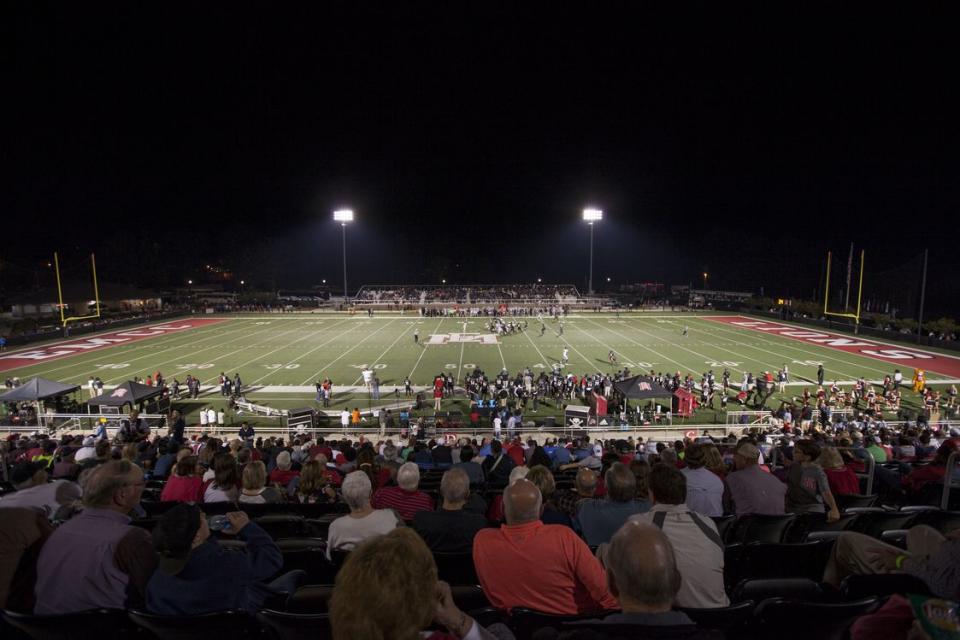
What did they find? That first season, Britney Wagner, an academic advisor, who was so compelling that Spectrum greenlit a series based on her starring Courtney Cox. Ronald Ollie, the big-hearted defensive lineman. Head Coach Buddy Stephens, whose behavior damn near caused a crisis of faith when he returned in the second season. D.J. Law, who fought through so much in his personal life just to step on the field. John Franklin III, a holy-shit-level athlete who seemed like he wanted to be anywhere but Scooba. All of them, in the lowest moments of their lives. The title isn't just a cute play on university-speak. One more mistake and the thing they love the most is stripped from them, which we see far too often in the series. As for the visuals: Last Chance U looks like a fever dream staged on AstroTurf, full of heart and heartbreak and football coaches doing football coach shit. Probably what it would look like if David Lynch directed Hard Knocks.
Somehow, Whiteley and his crew pulled Last Chance U off, mostly because the players trusted them enough to tell their stories. (We’ll get to that later.) Last Chance U interviews its subjects in whatever space is most intimate to them—their dorm room beds, or the driver’s seats of their cars—where, over the course of the series, they would share stories of loss, times where being in the wrong place at the wrong time led to a night in jail, what it felt like when their baby was born. You would see them in the classroom as much as you would on the field, watching educators like Season Three and Four's English professor, LaTonya Pinkard, fight using religion, literature, post-class therapy, anything, to leave a mark on their lives before it's too late.
Eventually, Last Chance U goes to the players' hometowns, friends and families opening their doors to every joy, secret, and heartbreak. There, Whiteley found moments both beautiful—fan-favorite linebacker Bobby Bruce with his newborn child—and devastating, like Season Two's Isaiah Wright detailing six years of abuse in foster care, his foster parents tying his brother up with zip ties and duct tape. Along the way, portraits of small-town America, featuring interviews with each town's residents, and nearly total immersion in their rituals—Halloween festivals and ferris wheels, diners older than the townspeople themselves.
Later on, the show moved to Kansas to follow the Independence Community College Pirates, led by Jason Brown, an all-timer of a shit-talker who would do interviews from his hot tub. In 2019, Whiteley brought the Last Chance U formula to Netflix’s Cheer, to perhaps his greatest mainstream success. Audiences fell in love with the mat-talking cheerleading squad from Navarro College—showing that the pain buried deep within college athletics, the fight to break free from what you were born into, goes far beyond the lights of a football stadium. Whiteley will always remember Season One of Last Chance U the most.
“I always go back to Season One, because it was such a disaster,” Whiteley says. “There was just so much that was going on both on and off the camera that it was just... that show just shouldn't have been made. It shouldn't have been as good as it was, and it's only because of a group of really talented people, many of which were operating in positions for the very first time, rising to the occasion and people coming together to produce something great.”
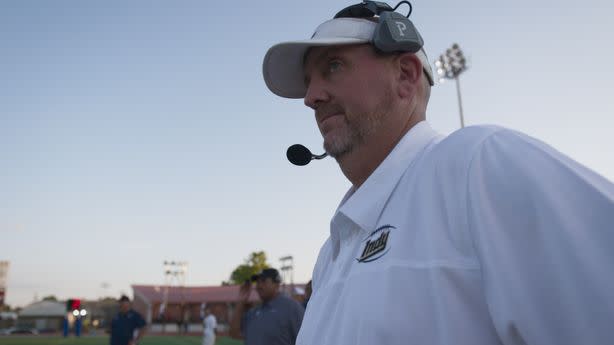
By Season Four of Last Chance U, Whiteley’s crew was running the air raid offense equivalent of documentary filmmaking. Which lets you capture all kinds of insanity. And moments. But documentaries don’t really have moments. They have Michael calling Scottie lazy. Movies have moments. Jerry Maguire, crew socks, “Old Time Rock and Roll.” That kind. Last Chance U? Last Chance U has moments, because its creators are usually thinking more big-screen epic, and less Sportscenter's "Top 10."
"A lot of times we go to the games almost as if its a short film with its own story," says Mark Morgan, a supervising editor on the show.
When it's gameday—usually at the end of each episode—the show gives a masterclass in editing, withholding and giving information at just the right moments, dropping a well-timed Young Thug record or two, so your nerves are even frayed at the end of a blowout. (Morgan added that it was a conscious decision to try and squeeze Young Thug into every season's soundtrack.) Sometimes, you'll even watch the game from the perspective of an injured player, forced to see the pain someone endures after they're shooed off the field, concussion symptoms slowly setting in.
"It's always been really exciting that have emotional mini-narratives within the game, like somebody who got injured, somebody who gets a play, The game tells us what it is," says Kate Hackett, an editor on the show.
Ask the Last Chance U fan in your life for a moment. Maybe you’ll get one of the only dorm room ragers the crew caught and put in the show, a night in at Indy stylized all honkey-tonk to Waylon Jennings’s “Shine.” Or when Coach Buddy got in a fistfight with a referee. (“LET HIM HANDLE IT!”) It could be the moment before Season Four’s rivalry game against the Coffeyville Red Ravens. It’s not what they did in the game. It’s how they came out of the tunnel beforehand, following Bobby Bruce. But you wouldn't know it. He had a freakish bunny mask on.
“Me and Bobby [Bruce], we was talking about what we were gonna wear for the game,” says Markiese King, a former wide receiver for the Pirates. “He was gonna go to Wal-Mart and get a mask... and said that's how he gonna come out.”
Zumalt knew the guys were cooking something up, but he didn’t see the mask until the last minute. “I remember seeing a gleam in [Terry’s] eye,” Whiteley remembers. Zumalt quickly snapped the frame rate to 60 fps, which is the hyper-cinematic setting that Peter King shot The Hobbit movies on. The result: The Indy Pirates walk out of the pregame tunnel in slow motion. Not Fast and Furious slow motion. Like coming to get you slow motion. Dramatic music. Ambiance. It’s Bobby Bruce, already a Donnie Darko-esque tragihero to begin with, in a pink bunny Halloween mask he bought at Wal-Mart. He kneels, rocking back and forth like he’s method acting as the Joker. The whole thing looks like it jumped out of a Freddy Kreuger nightmare.
“It's just dark and crazy and beautiful,” Whiteley says. “If there's any image that sums up the Indy Pirates, I think it's that one right there.”
King adds, for good measure: “I actually did the same thing, but I had on a different mask. I had a dog.”
It’s more accurate to call Last Chance U, at this point, its own genre, rather than a recurring Netflix series. Going by that, Season Five is the most a Last Chance U season has ever Last Chance Ued. There’s the weird shit that feels entirely too strange to classify as documentary: Laney’s star receiver, RJ Stern, is the grandson of The Mists of Avalon author Marion Zimmer Bradley—and he lives in her sanctuary for fantasy writers. There’s the sweaty and screamy football drama set to pitch-perfect needle drops. This season? Neil Young. “Blow the Whistle.” Plus, some football coach shit. At one point, Beam screams at some football thing, context notwithstanding, “At the strip club, you at least gotta give dollar bills!”
In Season Five, though, there’s a twist on the formula that lifts Last Chance U to the truest to life it’s ever been. California JUCO has its own athletics structure, the California Community College Athletic Association, with different rules than EMCC and Indy operated under. Mainly: Little to no financial or housing support from the school. Instead of following players back to their dorm rooms after practice, Last Chance U’s cameras trails Laney’s Dior Walker-Scott back to his car, where he lives throughout the season, blankets falling out of his open car door as he tries to settle in for the night. You meet offensive lineman Nu'u Taugavau, who stays at home with his two children in the evenings, watching them while his wife works and goes to beauty school—and is repeatedly told he can’t bring his daughters to class. So what does he do?
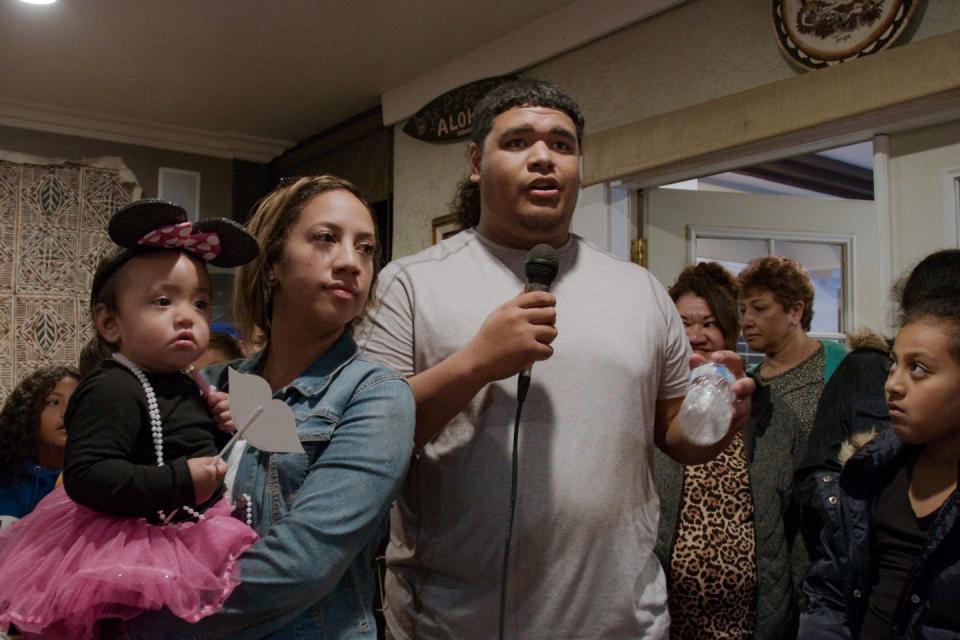
On top of that, Whiteley splices in a Parts Unknown-style profile of a gentrifying Oakland. The interviewees? The players and their families, who live hours away from Laney because they can’t afford to live there anymore. Episode Six of Last Chance U rides along with a Black police officer in the Oakland Police Department, Lieutenant Fred Shavies, who struggles to reconcile the reduction of the violence in his hometown with the nearing extinction of its identity. Coach Beam brings Lieutenant Shavies into a team meeting, where he tells his life story—fearing for his life growing up in a drug-ravaged Oakland, joining the police force as an adult. Meanwhile, you see pained looks on the players’ faces—this man represents the police force that killed Oscar Grant in 2009. It’s exactly the kind of messy, true-to-life scene Last Chance U is known for.
"George Floyd is new to the world, but I've been seeing the George Floyds for 40 years here in Oakland, right?" says Coach Beam about bringing in Lieutenant Shavies. "But what we needed to find out is that police are human beings—and the uniform of the job is different than who the human being is inside that uniform. So I wanted them to see Fred like who he was. He was them, right?"
Whiteley always knew that Season Five would be his last in football—which might not have even happened if not for Laney. "We thought every season was the last season," he says. "The first season, we didn't know there would be a second, and that was true every season," adding that Netflix, "had indicated to us [that Season Five] was most likely gonna be the last season." At the time, too, he was pitching Last Chance U: Basketball, which has since been filmed and will hit Netflix in 2021. (No word yet on Cheer Season Two.)
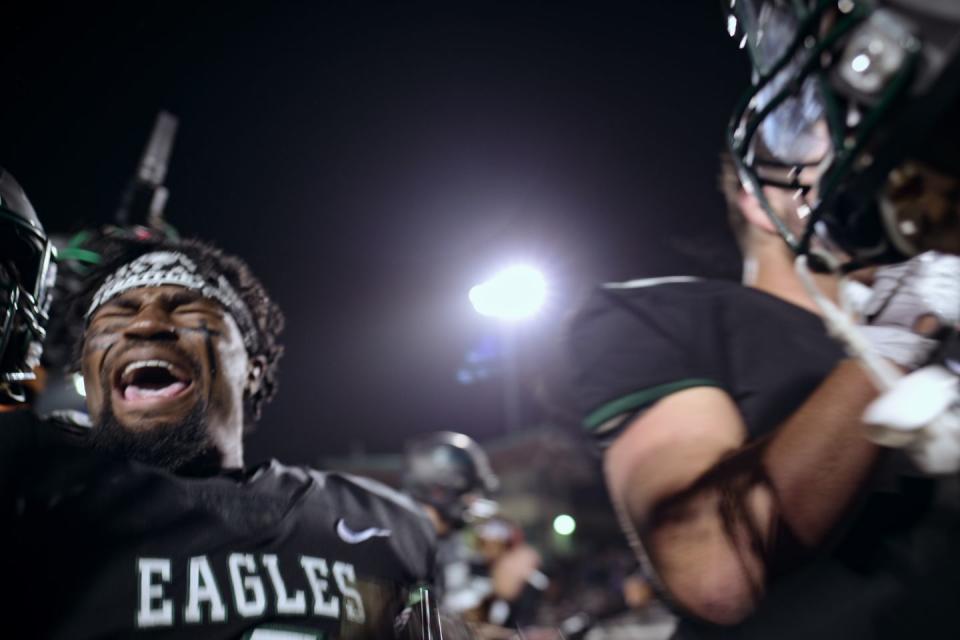
After Last Chance U leaves football, many of our sports documentaries will continue citing statistics off the cuff about how many college athletes are homeless, how immediate their need of financial support is, while lacking the depth and nuance of Last Chance U. Rarely will another documentary show a teenager skipping meals because he has five dollars in his account, fighting through PTSD symptoms from an abusive home, like we see with Walker-Scott in Last Chance U. Whiteley and Last Chance U shows way more often than it tells, but there’s at least one area that’s clear where these men are being failed.
“I know this: We have to rethink what we are doing in the exchange that's being offered to a college athlete for their services,” Whiteley says. “Generally, the education that we are providing is something that's largely meant to just keep them eligible to play football rather than truly prepare them for life outside of football. So to simply say, ‘Well, we can take these athletes and we're giving them this priceless education that if they just simply apply it, it's gonna serve them the rest of their life.’ I just don't believe that.”
If you're a Last Chance U alum and you join another football team, it gets talked about in the locker room. No one wants to come out and say it though. They really don't. It makes for a weird start to a budding football friendship—they know you before you know them.
Dakota Allen, who was featured on Season Two of Last Chance U, became the first and only player from the show to be drafted into the NFL. Since he joined the league in 2019, he’s been on three teams: The Los Angeles Rams, Oakland Raiders, and Jacksonville Jaguars. Yep. Most of his teammates have seen it. All of them talk about it.
“There a lot of people who do watch [Last Chance U],” Allen says. “And then when I do go to that team, it gets talked about in the locker room. So then the people who don't watch it, they'll be like, Hmm, I wonder what they're talking about. Then they'll go back and watch the show. And they'll be like, ‘Bro, I didn't know you were this superstar!’ And I'm like, ‘I'm not! I'm just trying to be like you.’”
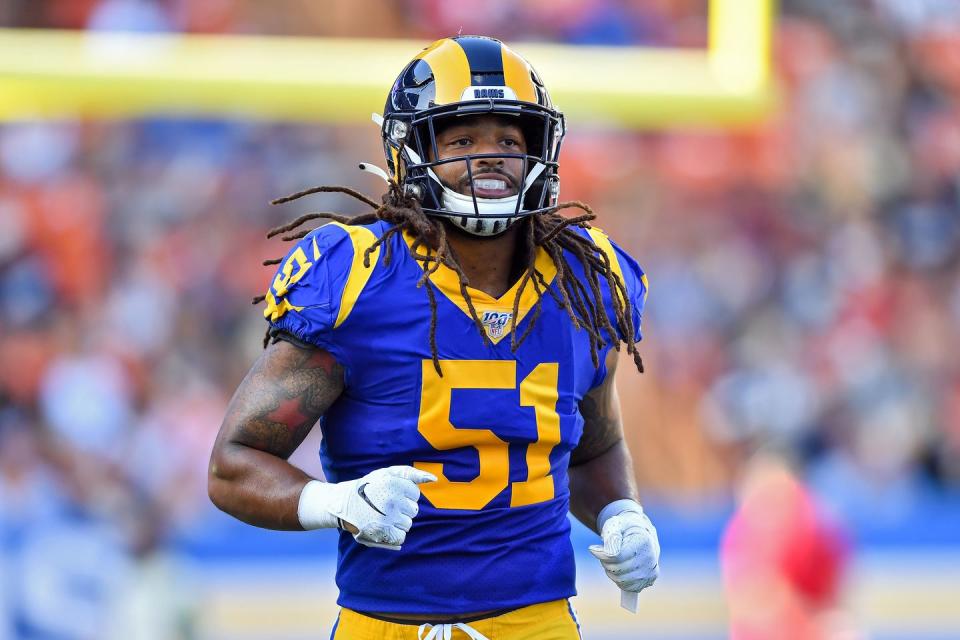
You could spend years trying to figure out Last Chance U’s thesis. But you know almost immediately that players like Allen are its raison d'être. When Allen was a freshman at Texas Tech, he was wrongfully charged with second-degree burglary and expelled from the school. Even though the charges were dropped, he still had to prove himself at EMCC. In Last Chance U, he’s revealed as not only a beast of a football player, but one of the kindest people you’ll ever meet. (Seriously. A minute into conversation with him, after thanking him for his time, he says, “I appreciate you wanting to give an interview!”) The next season, he re-enrolled at Texas Tech en route to an NFL payday.
“I feel like a big reason I am in the NFL is because the cameras showed my character off the field,” Allen says. “It's just such a blessing and it was an incredible opportunity that I didn't even know I was going into... I'm telling you, I think about it all the time.”
You know who else is always thinking about Last Chance U? Franklin III, who now plays for the Tampa Bay Buccaneers. But he couldn’t stop thinking about it even if he wanted to. It’s been five years since people watched him on the show, and he still gets recognized three to four times a day, and that’s not even counting the daily DMs from Last Chance U fans.
"I always tell people—going through it was the lowest part of my life,” Franklin III says. "That was my ultimate low and I hated it. But as I sit and look back on it, I was so thankful for it. That's the time where I grew the most as an individual... That's the greater gift I could ever have is to be able to leave that lasting impact on somebody. Before they quit, they think about me and see where I'm at now. And just give them that extra little bit of motivation, even though that was the worst time in my life.”
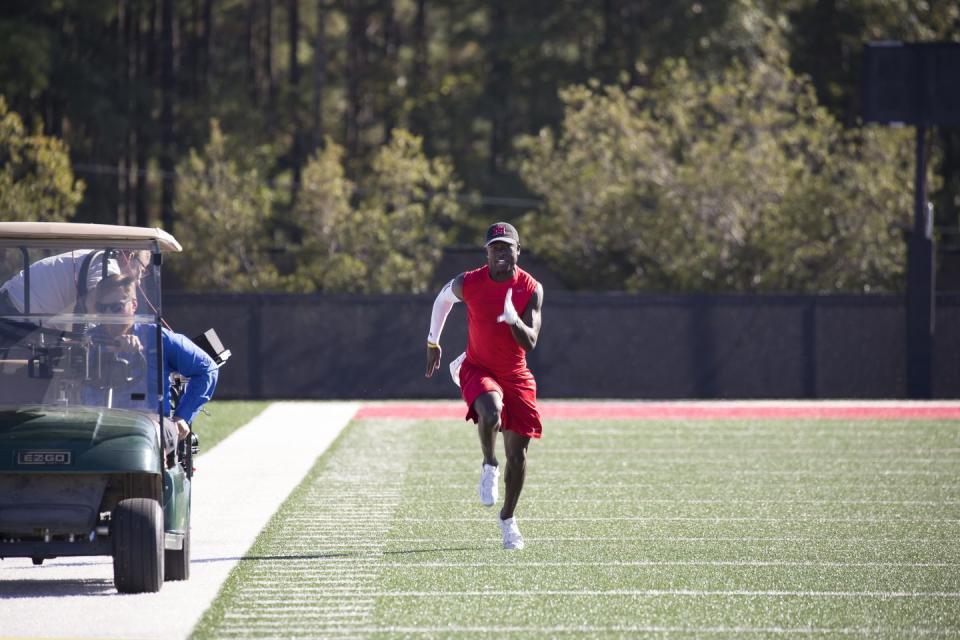
When Franklin thinks back to Scooba, he remembers going to the gas station to eat because the EMCC cafeteria would close at 9 p.m., and doing just about everything to pass the time, legitimately hitting soccer balls around with brooms in the parking lot because there was nothing else to do. Oh. One more thing. He remembers a certain office, with a certain couch, inhabited by a certain person.
“I mean... all the times in Ms. Wagner's office,” he says. (You also might be happy to know that Allen exclaimed, “Ms. Brittney!” at one point in his interview.) “Just kickin’ it and talking smack. You know, everybody always brings up the whole conversation with me and her, I laugh so much about that. I mean the first time I saw it, I was like, Dang, what is my mom gonna say when she sees this?”
Speaking of Ms. Brittney, how's her favorite EMCC alum doing? Ronald Ollie, who's arguably the most beloved player in Last Chance U history, with his make-your-week level of heart and humor. He's laughing away as always, rapping and making music in his spare time, surprising Wagner with the occasional catch-up call. Even though he went undrafted in the NFL, and didn't win a spot on the Oakland Raiders in a brief Hard Knocks cameo, he's still playing football, landing with the Toronto Argonauts of the CFL earlier this year. Five years after Last Chance U, he tries to be a role model for young people who need guidance, a shoulder, anything at all, just as he did as a 17-year-old in Scooba.
"Sometimes I reach out to kids, because I know I wish I had somebody to do that for me, that helped me a lot growing up," Ollie says. "Let them know, like: It's rough out here, life happens, but you still gotta keep your head on the goal and get what you want out of life.
All of the players interviewed for this story repeated one thing: Last Chance U really did show what life was like for them. Whiteley and his team got it right. And the players said they only told their stories—in such excruciating detail—because they got to know the people behind those expensive cameras. They damn near lived with them. Which is all a small miracle for a sports-doc world where its subjects often have final approval over the final cut. (Looking at a certain basketball GOAT. Or two.) Many of the players still keep in touch with the crew today, even five years since the early days in Scooba, where, sometimes, the only small-talk to be had was: "What did you eat today?"
“When they first came in, they asked me about telling my story,” Allen says. “I was a little skeptical because I just didn't want it to come off on TV different than how I wanted to say it. But I feel like the crew really put it together very well and very realistic. Like, they didn't make it look like something that it wasn't. I thank them forever for that.”
There's your long answer to one of the very few questions Last Chance U doesn't answer: The players are happy with Last Chance U. Talking to the alums, many whom still talk to each other, you get the sense that appearing on Last Chance U gives you membership in an exclusive fraternity, one that increases your chances of getting recognized in public about a thousandfold. Ollie loves it though. After talking about the wins and losses on the show that changed his life forever, he breaks into a very, very high-pitched dramatization of what it's like to meet a Last Chance U fan in the wild.
"Ohmygod, are you Ollie from Last Chance U?!" Ollie says, holding back that know-it-from-anywhere laugh. "We love you!"
You Might Also Like

